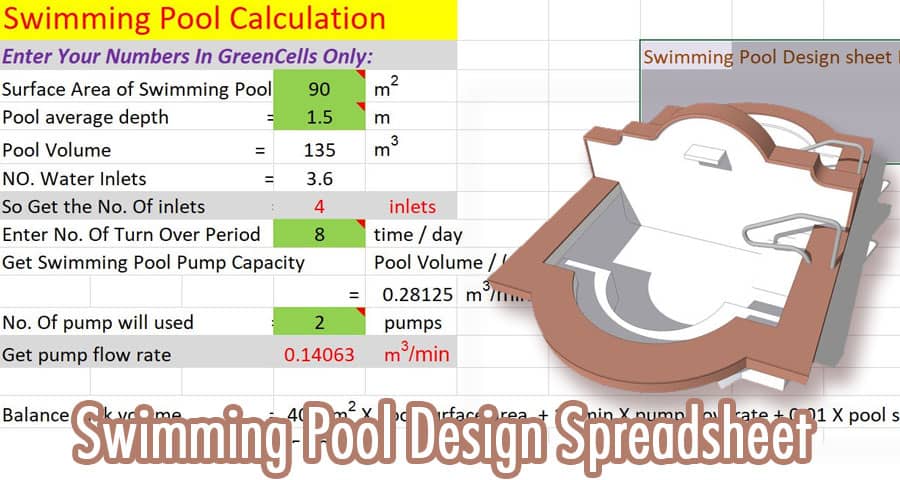Swimming Pool Design Spreadsheet

Introduction
Designing a swimming pool requires careful planning and consideration of various factors to ensure a functional and aesthetically pleasing result. To streamline the design process and facilitate accurate calculations, a swimming pool design spreadsheet can be a valuable tool.
Understanding Swimming Pool Design
Swimming pool design involves several key elements that contribute to the overall functionality and appeal of the pool. These elements include pool shape and size, water depth, circulation system, filtration system, heating options, and aesthetics. Designing a swimming pool requires careful consideration of the available space, budget constraints, user requirements, safety regulations, and local building codes.
The Role of a Spreadsheet in Swimming Pool Design
A spreadsheet can significantly simplify the swimming pool design process by providing a structured platform for calculations, data organization, and analysis. It allows designers to input various parameters, perform calculations, visualize designs, and make informed decisions based on accurate data. The flexibility and versatility of spreadsheets make them ideal for designing customized swimming pools tailored to specific requirements.
Components of a Swimming Pool Design Spreadsheet
To create a comprehensive swimming pool design spreadsheet, consider including the following components:
- Pool Dimensions and Shape: Provide input fields to define the desired pool shape and dimensions, including length, width, and depth. This information forms the foundation of the design and helps calculate the volume and surface area of the pool.
- Hydraulic Calculations: Include formulas to calculate the water flow rate, pipe size, and pump requirements based on the pool volume, turnover rate, and desired flow velocity. Hydraulic calculations ensure proper circulation and filtration of the pool water.
- Filtration System: Incorporate sections to specify the type and size of the filtration system, including sand filters, cartridge filters, or diatomaceous earth filters. Consider variables such as filtration media area, flow rate, and pressure drop for efficient filtration.
- Heating and Temperature Control: Include options to input the desired water temperature, heating system type (such as heat pumps or solar heaters), and insulation methods. These elements contribute to the comfort and usability of the pool.
- Chemical Balance and Water Treatment: Provide fields to input water chemistry parameters, such as pH, chlorine levels, and alkalinity. Incorporate calculations to determine chemical dosages based on pool volume, water test results, and desired water quality standards.
- Decking and Aesthetics: Consider sections to incorporate design elements such as pool decking, coping materials, lighting options, and landscaping. These components contribute to the overall aesthetics and ambiance of the pool area.
Benefits of Using a Swimming Pool Design Spreadsheet
Using a spreadsheet for swimming pool design offers several advantages:
- Efficiency: A spreadsheet streamlines the design process, automates calculations, and reduces the time required to make design adjustments or modifications.
- Accuracy: By utilizing formulas and functions, a spreadsheet ensures accurate calculations, minimizing human errors in complex design calculations.
- Visualization: Spreadsheets allow for the creation of charts, graphs, and visual representations of the pool design, aiding in decision-making and client presentations.
- Cost Optimization: With a comprehensive spreadsheet, designers can analyze costs associated with various design choices, materials, and equipment, helping clients make informed decisions based on their budget constraints.
- Documentation: A swimming pool design spreadsheet serves as a central repository for all design-related information, ensuring easy access, documentation, and sharing with project stakeholders.
Conclusion
A swimming pool design spreadsheet is a valuable tool for designers, architects, and pool builders. It simplifies the design process, facilitates accurate calculations, and allows for informed decision-making based on data-driven insights. By incorporating the essential components discussed above, a spreadsheet becomes a powerful resource for creating well-designed and functional swimming pools.
FAQs
Can a swimming pool design spreadsheet be customized for different pool types and sizes?
Yes, a swimming pool design spreadsheet can be customized to accommodate various pool types, sizes, and design preferences. By adjusting the input fields and formulas, designers can adapt the spreadsheet to meet specific project requirements.
How can a swimming pool design spreadsheet assist in complying with safety regulations?
A swimming pool design spreadsheet can include sections for safety-related parameters, such as fencing requirements, depths for different pool zones, and circulation system specifications to ensure compliance with safety regulations and local building codes.
Can a swimming pool design spreadsheet help in estimating construction costs?
Yes, a comprehensive swimming pool design spreadsheet can incorporate cost estimation sections where designers can input material costs, labor rates, and equipment expenses. By utilizing formulas, the spreadsheet can calculate and provide an estimate of the construction costs based on the design specifications.
Is it possible to include multiple design iterations in a swimming pool design spreadsheet?
Yes, a swimming pool design spreadsheet can accommodate multiple design iterations by creating different sections or tabs within the spreadsheet. Designers can explore various options, compare calculations, and visualize different design scenarios to make informed decisions.
Can a swimming pool design spreadsheet be shared with clients or other project stakeholders?
Yes, a swimming pool design spreadsheet can be easily shared with clients or other project stakeholders. Spreadsheets can be saved in various formats, such as Excel or PDF, and shared electronically via email or file-sharing platforms, ensuring efficient collaboration and communication throughout the design process.
